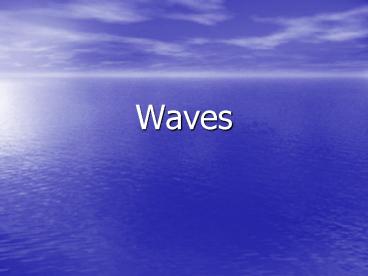Waves - PowerPoint PPT Presentation
1 / 29
Title:
Waves
Description:
Waves The Nature of Waves What is in a wave? A wave is a repeating disturbance or movement that transfers energy through matter or space. For example, during ... – PowerPoint PPT presentation
Number of Views:211
Avg rating:3.0/5.0
Title: Waves
1
Waves
2
The Nature of Waves
3
What is in a wave?
- A wave is a repeating disturbance or movement
that transfers energy through matter or space. - For example, during earthquakes, energy is
transferred in powerful waves that travel through
Earth.
4
Wave and Energy
- A pebble falls into a pool of water and ripples
form. - Because it is moving, the falling pebble has
energy.
5
- As it splashes into the pool, the pebble
transfers some of its energy to nearby water
molecules, causing them to move. - What you see is energy traveling in the form of a
wave on the surface of the water. - Raft
6
- The waves dont even carry the water along with
them. - Only the energy carried by the waves moves
forward. - All waves have this property
- They carry energy without transporting matter
from place to place.
7
Making Waves
- A wave will travel only as long as it has energy
to carry. - Anything moving up and down or back and forth in
rhythm is vibrating. - All waves are produced by vibrating matter
8
Mechanical Waves
- Some wave require matter to transfer the energy.
- The matter the waves travel through is called a
medium. - The medium can be a solid, a liquid, a gas, or a
combination of these.
9
- The two types of mechanical waves are transverse
waves and compressional waves.
10
Transverse Wave
- In a transverse wave, matter in the medium moves
back and forth at right angles to the direction
that the wave travels. - For example, a water wave travels horizontally as
the water moves vertically up and down.
11
Compressional Waves
- In a compressional wave, matter in the medium
moves back and forth along the same direction
that the wave travels. - The wave carries energy, but not matter, forward
along the spring.
12
- Compressional waves also are called longitudinal
waves
- Sound creates compressional waves.
13
Deep Water Waves
- A water wave causes water to move back and forth,
as well as up and down. - This motion causes both transverse and
compressional waves
14
Seismic Waves
- Forces in Earths crust can cause regions of the
crust to shift, bend, or even break.
- The breaking crust vibrates, creating seismic
waves that carry energy outward.
15
- Seismic waves are a combination of compressional
and transverse waves. - They can travel through Earth and along Earths
surface.
16
Wave Properties
17
The Parts of a Wave
- Transverse waves and compressional waves have
different characteristics crests and trough,
compressions and rarefactions. - They also have similar properties wavelength,
frequency, period, amplitude, and wave speed.
18
The Parts of a Transverse Wave
- A transverse wave has alternating high points,
crests, and low points, troughs.
Rest position is also called equilibrium.
19
Wavelength of Transverse Wave
- A wavelength, ?, is the distance between one
point on a wave and the nearest point just like
it.
- Wavelength is the distance from crest to crest or
trough to trough.
20
The Parts of a Compressional Wave
- A compressional wave has regions where the
particles are close together, compressions.
- And regions where the particles are further
apart, rarefactions.
21
The wavelength of a Compressional Wave
- A wavelength is the distance between two
neighboring compressions or two neighboring
rarefactions.
22
Amplitude
- Amplitude is related to the energy carried by a
wave. - The greater the waves amplitude is, the more
energy the wave carries.
23
Amplitude of a Transverse Wave
- The amplitude is the distance from the crest or
trough of the wave to the rest position of the
medium.
24
The Amplitude of a Compressional Wave
- The amplitude of a compressional wave is related
to how tightly the medium is pushed together at
the compressions. - The denser the medium is at the compressions, the
larger its amplitude is and the more energy the
wave carries.
25
Frequency, f
- The number of wavelengths that pass a fixed point
each second. - The rate of vibration
- Find the frequency of a transverse wave by
counting the number of crests or troughs that
pass by a point each second. - Expressed in Hertz (Hz).
26
Period, T
- The amount of time it takes one wavelength to
pass a point. - As the frequency of a wave increases, the period
decreases. - Units of seconds, s.
27
Frequency Period
- The frequency, f, and period, T, are reciprocals
of each other.
28
Speed of a Wave
- The speed of a wave depends on the medium it is
traveling through. - Sound travels faster in solids than gases.
- Light travels faster in air than water.
29
Calculating the Speed of a Wave
- vfl
- Where
- v is speed in m/s
- f is frequency in Hz
- l is wavelength in m































